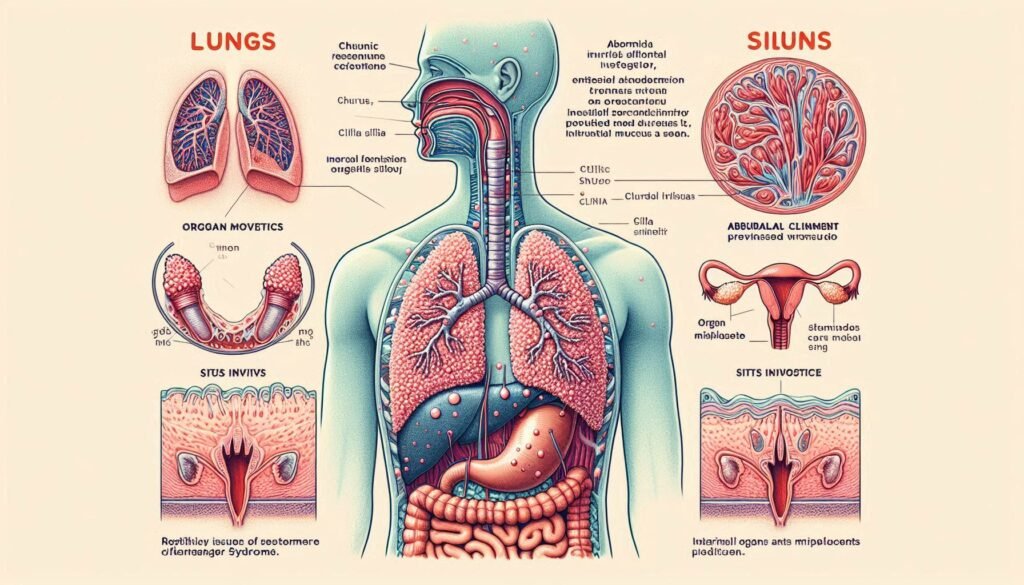Keshan Disease Syndrome is a rare yet significant health condition that often flies under the radar. Linked closely to selenium deficiency, this syndrome primarily affects cardiac function and can lead to severe complications if left unaddressed. While it may not be widely known outside specific regions, understanding Keshan Disease Syndrome is crucial for those living in endemic areas and healthcare professionals alike.
This blog post will take you on an informative journey through the various facets of Keshan Disease Syndrome – from its geographical distribution and historical context to diagnostic approaches and current research trends. Join us as we explore how this unique interplay of nutrition, environment, and genetics impacts lives around the world.

Keshan Disease Syndrome: A Selenium Deficiency Disorder
Keshan Disease Syndrome is primarily caused by selenium deficiency, a vital trace mineral essential for various bodily functions. Selenium plays a key role in antioxidant defense and thyroid hormone metabolism. When levels fall too low, it can lead to severe health issues.
This condition predominantly affects the heart, resulting in cardiomyopathy—a disease that weakens the heart muscle and hampers its ability to pump blood effectively. The syndrome was first identified in Keshan County, China, where soil selenium levels are notably low.
“How Does Holt-Oram Syndrome Impact Heart Development?”
Interestingly, this disorder highlights the intricate connection between nutrition and overall health. Addressing selenium deficiency through dietary changes or supplementation can significantly impact those at risk of developing Keshan Disease Syndrome.
Geographical Distribution: Endemic Regions and Risk Factors
Keshan Disease Syndrome primarily occurs in specific geographical regions where soil selenium levels are low. These areas include parts of China, particularly the northeastern provinces. Other countries such as Siberia and certain regions of Africa also report cases.
The disease is more prevalent among populations that rely heavily on locally sourced food, which may lack adequate selenium. Environmental factors like agricultural practices further exacerbate the deficiency.
“What Causes Hunter Syndrome? Enzyme Deficiency Guide”
Risk factors include socioeconomic status and diet quality, with poorer communities often facing higher incidence rates. Limited access to diverse foods means these populations miss out on crucial nutrients necessary for overall health and well-being.
Historical Context: Discovery and Early Research in China
Keshan Disease Syndrome was first identified in the 1930s in Keshan County, Heilongjiang Province, China. Local populations exhibited high rates of heart disease that baffled scientists and physicians at the time. Initial observations linked these cases to environmental factors and dietary deficiencies.
In the early 1950s, researchers conducted studies revealing a correlation between selenium deficiency and cardiac dysfunction. This groundbreaking work laid the foundation for understanding how micronutrient availability impacts health outcomes.
“Why Is HELLP Syndrome Dangerous During Pregnancy?”
As research progressed throughout the decades, it became clear that this condition primarily affected children and women during childbearing years. The findings spurred further investigation into dietary habits and local agricultural practices contributing to selenium deficiency.
Etiology: Interplay Between Selenium Deficiency and Viral Infections
Selenium deficiency plays a crucial role in the development of Keshan Disease Syndrome. This mineral is essential for maintaining proper immune function and overall health. When selenium levels drop, the body becomes more susceptible to various infections.
“How Does Hyperostosis Syndrome Affect Bone Growth?”
Viral infections have been shown to interact with selenium deficiency, exacerbating cardiac issues. The Coxsackie B virus is particularly implicated in this context, as it can trigger or worsen heart inflammation in those lacking adequate selenium.
The combination of low selenium and viral infection creates a perfect storm for cardiomyopathy to develop. Understanding this interplay is key in addressing both prevention and treatment strategies for Keshan Disease Syndrome.
Pathophysiology: How Selenium Deficiency Affects Cardiac Function
Selenium plays a crucial role in maintaining cardiac health. Its deficiency leads to impaired antioxidant defenses, resulting in oxidative stress that damages cardiac cells. This cellular damage can disrupt normal heart function.
“What Are The Signs of Hurler Syndrome in Children?”
The heart relies on selenium for the synthesis of selenoproteins, which are vital for regulating inflammation and cellular repair. Without adequate selenium, these processes falter, contributing to myocardial injury and dysfunction.
Additionally, low selenium levels impact energy metabolism within heart tissues. The myocardium struggles to produce ATP efficiently, leading to weakened contractility and ultimately affecting overall cardiovascular performance. Understanding this relationship highlights the importance of sufficient selenium intake for heart health.
Clinical Manifestations: Cardiomyopathy and Associated Symptoms
Keshan Disease Syndrome primarily manifests as cardiomyopathy, a severe condition affecting the heart muscle’s ability to pump blood effectively. Patients often experience fatigue, shortness of breath, and palpitations, which can significantly impair their daily activities.
“How Does Iatrogenic Cushing’s Syndrome Develop?”
In addition to these classical symptoms, individuals may also present with edema or fluid retention in the legs and abdomen. This occurs due to heart failure resulting from weakened cardiac function.
Arrhythmias are another concerning manifestation. Irregular heartbeats can lead to further complications and increase the risk of sudden cardiac events. These diverse clinical presentations highlight the serious impact Keshan Disease has on cardiovascular health.
Acute vs. Chronic Keshan Disease: Differentiating Features
Acute Keshan disease typically presents with sudden onset symptoms, including severe heart failure and arrhythmias. Patients may experience extreme fatigue, shortness of breath, and palpitations. This form often occurs in younger individuals exposed to viral infections alongside low selenium levels.
Chronic Keshan disease develops more gradually over time. Individuals may present with less severe cardiac dysfunction but can sustain long-term damage if untreated. Symptoms are subtle initially, such as mild fatigue or irregular heartbeats.
Differentiating these two forms is crucial for timely intervention. Acute cases require immediate medical attention, while chronic cases benefit from ongoing monitoring and management strategies that include nutritional support and lifestyle adjustments.
Diagnostic Approaches: Biomarkers and Imaging Techniques
Diagnosing Keshan Disease Syndrome involves a combination of biomarkers and imaging techniques. Serum selenium levels are the primary biomarker used to assess deficiency. A value significantly below normal indicates a potential risk for developing the disease.
Electrocardiography (ECG) plays a crucial role in identifying cardiac abnormalities associated with this condition. Typical findings may include changes like ST-segment depression or T-wave inversions, which indicate myocardial stress.
Echocardiography further complements diagnosis by visualizing heart structure and function. It can reveal left ventricular hypertrophy and reduced ejection fraction, helping healthcare providers gauge the severity of cardiac impairment linked to selenium deficiency.
Selenium Status Assessment: Methods and Interpretation
Assessing selenium status is crucial for understanding Keshan Disease Syndrome. Several methods are available, with serum selenium concentration being the most commonly used biomarker. A blood test can provide a snapshot of recent dietary intake and overall selenium levels.
Another method involves measuring selenium in hair or nail samples, offering insight into long-term exposure. These biological matrices reflect accumulated levels over time rather than just immediate consumption.
Interpreting these results requires careful consideration of reference ranges and regional variations in soil selenium content. Public health officials often analyze local diets to better contextualize individual assessments within community-wide nutrition profiles.
Electrocardiographic and Echocardiographic Findings in Keshan Disease
Electrocardiography (ECG) is crucial in diagnosing Keshan Disease Syndrome. Patients often exhibit distinctive changes such as ST-segment elevation or depression, which signal underlying cardiac issues. These alterations can indicate myocardial injury and electrical disturbances.
Echocardiographic evaluations reveal characteristic findings like reduced left ventricular function and chamber dilation. Abnormal wall motion patterns may be observed, suggesting compromised cardiac performance.
Combining ECG results with echocardiographic data enhances diagnostic accuracy for this rare condition. Recognizing these specific cardiological indicators allows healthcare providers to assess the severity of Keshan Disease effectively and tailor treatment accordingly.
Treatment Strategies: Selenium Supplementation and Cardiac Support
Selenium supplementation is the cornerstone of treatment for Keshan Disease Syndrome. This approach aims to restore adequate selenium levels in affected individuals. Dosage varies based on dietary intake and severity of deficiency, so medical supervision is crucial.
In addition to selenium, cardiac support plays a significant role in managing symptoms. Patients may require medications that improve heart function and reduce workload on the heart muscle. Lifestyle modifications like a balanced diet can further enhance health outcomes.
Regular monitoring of selenium status is essential during treatment. Adjustments in supplementation should be made as necessary to ensure optimal recovery while minimizing risks associated with excess intake or deficiencies.
Prevention Programs: Public Health Initiatives in Endemic Areas
Public health initiatives play a crucial role in combating Keshan Disease Syndrome, particularly in endemic regions. These programs focus on increasing community awareness about the importance of selenium and its sources. Education campaigns help inform individuals about dietary changes that can mitigate the risk.
Government agencies often collaborate with local organizations to distribute selenium supplements, especially during critical periods when deficiency is prevalent. Screening programs are also implemented to identify at-risk populations early.
Agricultural practices are another focal point for prevention efforts. Encouraging farmers to enrich soil with selenium can improve crop quality and enhance regional food security against this disorder.
Nutritional Interventions: Balancing Selenium Intake
Nutritional interventions play a crucial role in managing Keshan Disease Syndrome. Ensuring adequate selenium intake is essential for preventing and treating this condition. Foods rich in selenium include Brazil nuts, fish, poultry, eggs, and whole grains.
In regions where soil selenium levels are low, dietary adjustments become imperative. Supplementation may also be necessary to achieve optimal levels. Monitoring dietary habits helps maintain balanced nutrition.
Public education on the importance of selenium can empower communities at risk. Knowledge about food sources and proper supplementation strategies is vital to combat deficiencies effectively and improve overall health outcomes related to Keshan Disease Syndrome.
Complications and Long-term Cardiac Sequelae
Keshan Disease Syndrome can lead to significant complications affecting cardiac health. Patients often experience progressive heart dysfunction, which may result in congestive heart failure. The myocardium becomes weakened due to prolonged selenium deficiency.
Long-term sequelae can be serious, including arrhythmias and increased risk of sudden cardiac death. Damage to the heart muscle is not always reversible, making early intervention critical.
Moreover, individuals who have suffered from Keshan Disease may face challenges in daily activities due to reduced exercise tolerance. Ongoing monitoring and supportive care are essential for managing these long-term effects effectively.
Pediatric Keshan Disease: Special Considerations in Children
Pediatric Keshan Disease syndrome poses unique challenges for children. Young patients are particularly vulnerable due to their developing bodies and nutritional needs. Selenium deficiency can disrupt growth, leading to serious health implications.
Symptoms in children may manifest differently than in adults, often showing as fatigue, weakness, or respiratory difficulties. Early detection is crucial for effective intervention.
Management strategies must be tailored specifically for pediatric populations. This includes monitoring selenium levels closely and ensuring appropriate dietary intake. Health professionals need to consider the psychological impact on young patients and their families when addressing this complex condition.
Environmental Factors: Soil Composition and Agricultural Practices
Soil composition plays a crucial role in the prevalence of Keshan Disease Syndrome. Areas with selenium-deficient soils often see higher rates of this condition. Farming practices can impact soil health, affecting selenium levels and crop quality.
Agricultural methods that deplete nutrients can exacerbate deficiencies. Monoculture farming, for instance, limits biodiversity and may lead to nutrient-poor crops. This creates a cycle where communities consume food lacking essential minerals like selenium.
Moreover, environmental factors such as industrial pollution can further diminish soil quality. Contaminants may inhibit the absorption of vital nutrients by plants, contributing to a higher risk of diseases associated with deficiencies like Keshan Disease Syndrome.
Genetic Susceptibility: Emerging Research on Predisposing Factors
Recent studies have unveiled the role of genetic factors in Keshan Disease Syndrome. Certain gene polymorphisms may influence how individuals metabolize selenium, making them more susceptible to deficiency.
Research has identified specific genes related to antioxidant defense mechanisms that could predispose some populations to this condition. Individuals with variations in these genes might experience exacerbated cardiac issues when facing low selenium levels.
Understanding genetic susceptibility is crucial for developing targeted prevention strategies and personalized treatments. As science progresses, identifying at-risk individuals based on their genetics might enhance early intervention efforts and improve outcomes for those affected by Keshan Disease Syndrome.
Global Health Perspective: Lessons from Keshan Disease
Keshan Disease Syndrome serves as a critical case study for global health initiatives. Its roots in selenium deficiency highlight the importance of micronutrient availability in preventing disease. This condition underscores how nutritional deficiencies can lead to significant health crises, particularly in vulnerable populations.
The geographical distribution of Keshan Disease illustrates the need for targeted public health strategies. Countries with low soil selenium levels must prioritize nutrition education and supplementation programs.
Furthermore, the interplay between environmental factors and human health emphasizes the necessity for sustainable agricultural practices. Integrating these lessons into broader healthcare frameworks may improve outcomes not just locally but globally, fostering resilience against similar syndromes worldwide.
Current Research: Molecular Mechanisms and Potential Therapies
Recent studies are delving into the molecular mechanisms behind Keshan Disease Syndrome, focusing on how selenium deficiency impacts cardiac cells. Research highlights that low selenium levels may lead to oxidative stress, resulting in cellular damage and inflammation within heart tissues. This understanding opens avenues for targeted interventions.
Investigators are exploring potential therapies that enhance selenium bioavailability or mimic its effects on a cellular level. Innovative compounds show promise in modulating inflammatory pathways associated with this syndrome.
Ongoing clinical trials aim to assess the efficacy of these treatments in affected populations. The hope is to establish evidence-based protocols for managing Keshan Disease Syndrome effectively through both dietary and pharmacological means.
Living with Keshan Disease: Management and Quality of Life
Living with Keshan Disease Syndrome can be challenging, yet effective management strategies play a crucial role in enhancing quality of life. Patients are often advised to adopt a balanced diet rich in selenium, which can help alleviate symptoms associated with the disorder. Regular follow-ups with healthcare professionals ensure that any complications are monitored closely.
Support groups provide emotional and psychological benefits, helping individuals cope with their diagnosis. Additionally, engaging in light physical activity under medical guidance promotes heart health without overexertion.
Understanding this rare condition allows patients and families to navigate its complexities more effectively. With advancements in research and treatment options, those affected by Keshan Disease Syndrome have improved prospects for leading fulfilling lives despite their challenges.


